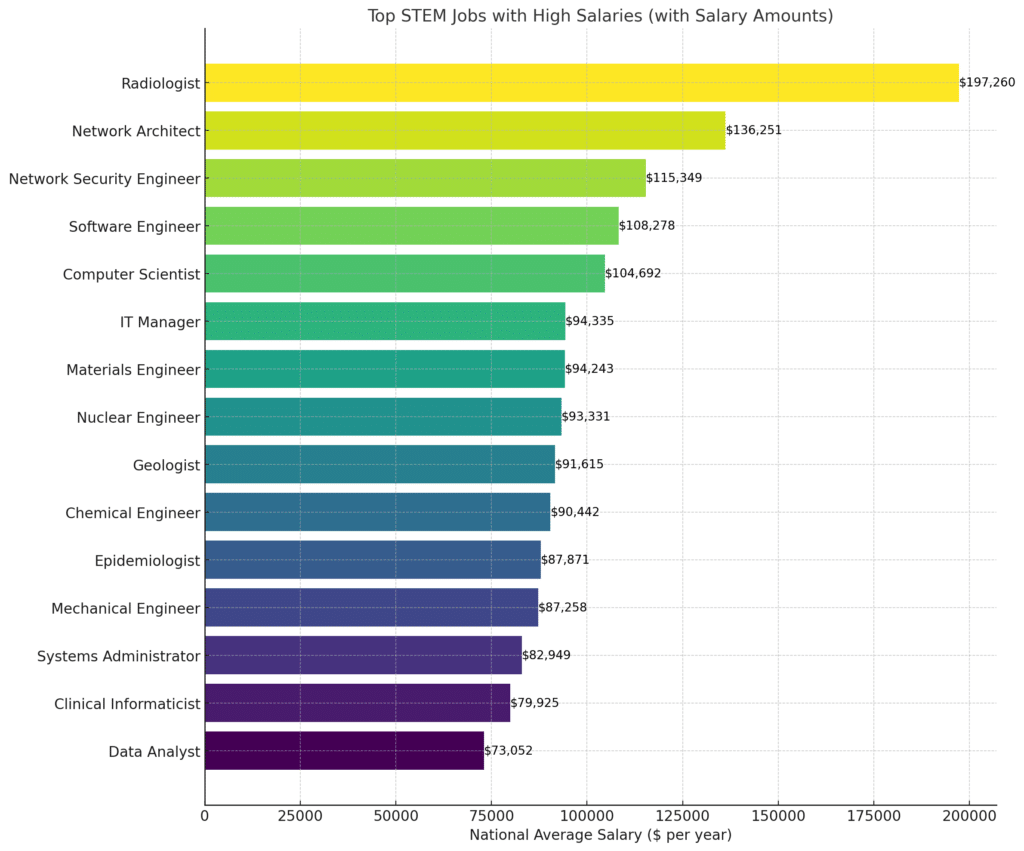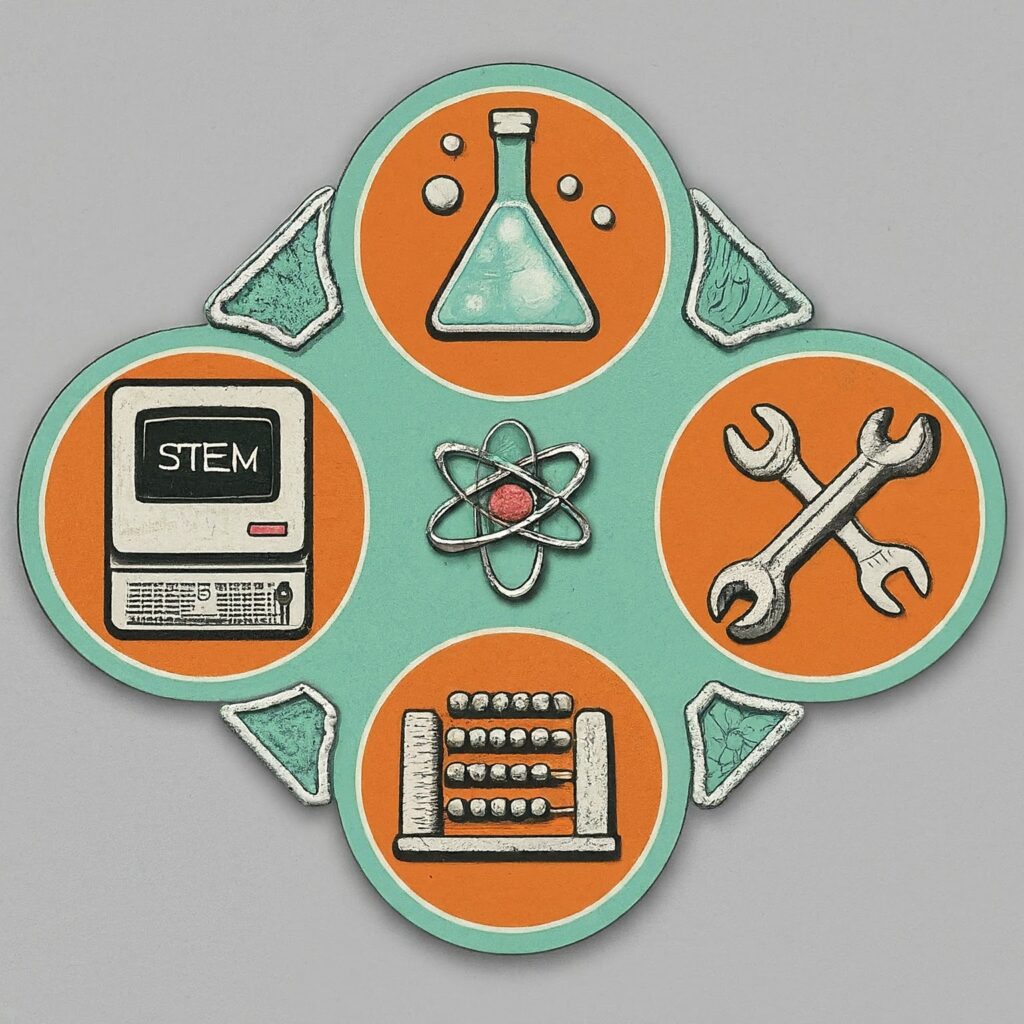What is STEM?
STEM—Science, Technology, Engineering, and Mathematics—encompasses disciplines that are pivotal in driving innovation and addressing real-world challenges. EDsmart's comprehensive guide delves into the significance of STEM education, its impact on career opportunities, and how it equips students with critical thinking and problem-solving skills essential for today's rapidly evolving world.
STEM fields—encompassing science, technology, engineering, and mathematics—are foundational to a wide range of disciplines that drive innovation and progress.
These areas play a crucial role in advancing technology and knowledge, contributing to problem-solving and critical thinking in various industries.
Table of Contents
The importance of STEM extends well beyond individual career prospects; it underpins economic growth and global competitiveness, and it presents solutions to many contemporary challenges.
Despite their significance, STEM industries face a unique conundrum.
While they are expanding rapidly, creating abundant opportunities, there is a noticeable gap in qualified candidates to fill these roles. This scarcity is a hurdle for industries striving to keep pace with technological advances and the ever-changing economic landscape.
As students and professionals consider their fields of study and career paths, STEM offers a compelling option with its diverse opportunities and its pivotal role in shaping the future.
Key Takeaways
- STEM fields are integral for technological advancement and innovation.
- There is a high demand for skilled professionals within STEM careers.
- STEM education is vital for economic development and global competition.
Exploring the Domains of STEM
STEM encompasses a broad range of academic and professional fields where the exploration of natural and applied sciences meshes with analytical rigor.
Central to STEM are fields such as biology, physics, chemistry, and subsets of life sciences and ecology, which delve into the intricacies of living organisms and their environments. These areas often employ the scientific method to understand the world.
In technology and engineering, the focus shifts to the application of scientific principles to design solutions to real-world problems. This includes computer science, IT, electronics, and various engineering disciplines — all united by a foundational reliance on mathematics.
Mathematical fields like algebra, calculus, and geometry provide the tools for modeling and problem-solving across STEM.
The inclusion of certain disciplines within STEM can spark debate.
Social sciences such as psychology, economics, and anthropology —while rich in empirical study— are often categorized separately due to their distinct methodologies. However, some broader interpretations of STEM embrace these fields, alongside architecture and select health and medical fields, recognizing the common thread of systematic inquiry and analytical application.
Consequently, STEM takes on an interdisciplinary approach, bridging natural sciences with applied disciplines and often overlaps with the arts, as seen in the STEAM education model where design and creativity play pivotal roles.
The Significance of STEM in Education
STEM education serves as a cornerstone for empowering the workforce of tomorrow. In an era where innovation is rapid, a robust STEM curriculum is crucial for economic growth and maintaining the United States' standing in the global economy.
- Demand for STEM Professionals: The available jobs far outnumber qualified candidates, signaling a gap that education aims to close.
- Government Investment: Initiatives like the funding contributions of recent administrations underline the importance of STEM in national strategies.
- Diversity and Inclusion Efforts: Programs aimed at engaging women and underrepresented groups reflect the push towards a more diverse and inclusive STEM workforce.
- Integration into K-12 Education: Incorporating project-based learning and integrated learning experiences from an early age sets a foundation for critical problem-solving skills and real-world application.
- Higher Education Incentives: Scholarships and partnerships between universities, nonprofits, and government entities offer motivators for students to pursue STEM degrees.
- Benefits Beyond Personal Career: A strong STEM education fosters competencies like critical thinking and hands-on experience that are vital for societal issues, including public health and economy.
Popular Paths in STEM
STEM fields offer diverse career paths, with many opportunities in sectors like private corporations, educational institutions, research facilities, and government agencies.
Candidates with STEM qualifications often rise into management roles or enhance their expertise through further education and research endeavors. Here is a snapshot of sought-after STEM careers, highlighting median salaries and job growth projections:
- Software Developers: Specialists in creating and improving applications with a median salary of $109,020 and a substantial 25% job growth rate.
- Data Analytics and Statisticians: Experts who interpret data for businesses, with incomes around $96,280 and a high job growth projection of 31%.
- Computer Systems Analysts: Professionals who analyze and optimize IT systems, earning a median salary of $99,270 and witnessing a 9% job growth outlook.
- Mechanical and Civil Engineers: Engineers designing structures and machinery, making near $95,300 and $80,180 respectively, with a job growth of 10% for industrial engineering roles.
- Database Administrators: Responsible for managing databases with earnings about $101,000 and a 9% job growth forecast.
Each role requires a blend of expertise in areas such as programming, systems analysis, and engineering principles.
The demand for these positions is fueled by advances in technology and the ever-growing reliance on data-driven decision-making in both the private and public sectors. Qualified candidates with a strong background in mathematics, computer programming, and analytics will find numerous opportunities across these high-growth STEM fields.
Reasons to Choose a STEM Major
Proficiency in Mathematics
Mathematics is a cornerstone of STEM fields. Careers in STEM often entail a robust grasp of advanced math. Those less enthusiastic or challenged by math might consider other career paths or less math-intensive STEM roles.
Attributes of Math-Adept Individuals
- Strong analytical skills
- Aptitude for complex problem-solving
- Precision in numerical operations
Passion for Technological Advancements
At the core of several sought-after professions lies an affinity for technology. An inclination towards innovating with computers, vehicles, and other technological devices can be the driving force for a fulfilling career in STEM.
Characteristics of Technology Enthusiasts
- Eagerness to engage with the latest tech
- A knack for understanding digital systems
- Excitement about technological problem-solving
Preference for Desk-Based Occupations
For those inclined towards less physically demanding roles that involve minimal social interaction, a computer-centric job within the STEM sector may prove suitable.
Preferences Indicative of a Fit for Computer-Centric Roles
- Comfort with prolonged computer use
- Solitary work environment
- Structured tasks with clear objectives
Financial Aspirations
One of the enticing aspects of STEM careers is the potential for lucrative earnings. Emerging from college with a STEM degree may set the stage for a financially prosperous professional journey.
Financial Benefits Associated with STEM Jobs
- High entry-level salaries
- Promising salary growth potential
- Economic stability and career longevity
Common Inquiries Regarding STEM Education
Distinctive Characteristics of STEM Education Compared to Conventional Methods
STEM education focuses on integrating disciplines in a way that encourages active learning rather than passive absorption of facts. In contrast to traditional education, which often delivers subjects in isolation, STEM emphasizes interconnected learning with real-world applications. It promotes critical thinking, problem-solving, and collaborative skills, replacing the standard teacher-driven approach with experiential projects and inquiry-based learning.
STEM's Influence on Plant Biology
In the realm of plant biology, STEM merges life sciences with technological advances to address complex biological issues. This interdisciplinary approach facilitates innovative research in genetics, bioinformatics, and environmental science, leading to advancements in sustainable agriculture, disease resistance, and understanding ecosystem dynamics.
Salary Expectations in STEM Careers
STEM fields like science and engineering offer high-paying jobs for those who excel in these subjects. The skills you learn, like critical thinking and problem-solving, are in high demand. With a STEM career, you can make good money and have a real impact on the world. Below is a sample of STEM salaries per Indeed.com.
Software Engineer Salaries in the US
Software engineer salaries in the US vary widely depending on experience, location, and employer.
- Average salary: $105,439 annually, with bonuses around $5,000.
- Range: $66,363 to $167,522.
- Top cities: San Francisco and Santa Clara ($151,202 and $147,917 average).
- Top companies: Meta, Salesforce, and Apple (average over $162,000).
- Experience matters: Salaries increase with experience, from $98,524 for beginners to $132,643 for those with 10+ years.
- Total compensation: Includes bonuses, stock options, benefits like health insurance, and professional development opportunities.
Biomedical Engineer Salaries in the US
Biomedical engineering offers a rewarding career path at the intersection of healthcare and technology.
- Average salary: $85,926 annually, with a range of $57,592 to $128,199.
- Demand is high: Openings exist at government institutions (like the VA: $130,148-$169,195) and tech firms.
- Location matters: Cities like Iowa City and Cincinnati offer higher salaries.
- Top employers pay well: The FDA and Medtronic offer above-average salaries.
- Compensation beyond salary: Health insurance and other benefits are common.
- Not just about money: While salaries are good, only 54% are satisfied due to cost of living and job challenges.
Data Science Salaries in the US: Booming Field, Big Rewards
Data science is a hot career in the US.
- Average salary: $124,234 annually, with a range of $80,188 to $192,474.
- Demand is high: Jobs exist from remote Staff roles ($238,000) to Associate positions.
- Top companies pay well: Capital One, Apple, and Meta offer over $167,000.
- Experience matters: 3-5 years gets you $143,158.
- Skills matter: Cloud and DevOps expertise earns a premium.
- Good benefits: Expect health insurance, 401(k)s, and flexible work.
- Satisfied with pay: 68% of data scientists find their salaries fair.
Environmental Science Careers
Environmental science tackles pressing environmental issues.
- Average salary: $65,547, with a range of $44,611 to $96,309.
- Jobs everywhere: From Tetra Tech in California ($67,000-$85,225) to BrightPath in Tennessee ($95,000-$115,000).
- Top employers: Mix of private firms (Conetec) and government agencies (Rhode Island).
- Location matters: San Diego and Richland offer higher salaries for specialized skills.
- Pay and satisfaction: Only 46% are happy with pay, highlighting a need for salary adjustments.
- Benefits: Expect health insurance, 401(k)s, and paid time off.
- Promising future: Growing focus on sustainability creates more opportunities.
Top STEM Jobs with High Salaries

STEM Grads: Top Pay and Promising Careers
A recent Federal Reserve Bank analysis shows STEM majors (Science, Technology, Engineering, Math) are earning the most compared to other recent grads (ages 22-27 with bachelor's degrees). Here's why STEM is a great choice:
- Highest starting salaries: Engineering majors like chemical, computer, aerospace, and electrical engineering lead the pack.
- Strong salary growth: Expect your income to jump 35% or more by mid-career.
- Science majors do well too: Their salaries typically increase by 40% over their careers.
- Lower unemployment: STEM jobs are in high demand, meaning a lower chance of being unemployed.
- Avoid lower-paying fields: Consider other majors carefully, as education, hospitality, and theology may offer lower salaries and higher unemployment rates.
| Major | Unemployment rate | Underemployment rate | Median wage, early career | Median wage, mid-career |
|---|---|---|---|---|
| Agriculture | 2.4% | 52.1% | $45,000 | $70,000 |
| Animal/plant sciences | 4.4% | 52.5% | $42,000 | $67,000 |
| Environmental studies | 5.1% | 50.2% | $45,000 | $68,000 |
| Architecture | 2.1% | 29.1% | $50,000 | $85,000 |
| Ethnic studies | 4.4% | 53.7% | $45,000 | $66,000 |
| Communications | 5.8% | 52.7% | $47,000 | $75,000 |
| Journalism | 6.5% | 47.7% | $45,000 | $75,000 |
| Mass sedia | 8.4% | 51.7% | $40,000 | $75,000 |
| Advertising/public relations | 4.6% | 39.2% | $50,000 | $80,000 |
| Information systems & management | 6.4% | 24.7% | $54,000 | $90,000 |
| Computer science | 4.8% | 19.1% | $73,000 | $105,000 |
| General education | 1.8% | 22.9% | $40,200 | $51,000 |
| Early childhood education | 3.1% | 24.5% | $40,000 | $43,000 |
| Elementary education | 1.8% | 15.2% | $40,000 | $48,000 |
| Secondary education | 2.6% | 27.0% | $40,400 | $52,000 |
| Special education | 2.7% | 17.7% | $40,000 | $52,000 |
| Miscellaneous education | 0.6% | 16.7% | $40,000 | $56,000 |
| General engineering | 5.9% | 25.3% | $60,000 | $100,000 |
| Aerospace engineering | 6.6% | 27.7% | $72,000 | $112,000 |
| Chemical engineering | 4.1% | 19.6% | $75,000 | $120,000 |
| Civil engineering | 3.4% | 15.1% | $65,000 | $100,000 |
| Computer engineering | 3.7% | 17.8% | $74,000 | $114,000 |
| Electrical engineering | 3.2% | 15.4% | $70,000 | $109,000 |
| Industrial engineering | 4.6% | 18.3% | $70,000 | $100,000 |
| Mechanical engineering | 5.3% | 15.8% | $70,000 | $105,000 |
| Miscellaneous engineering | 3.4% | 22.9% | $68,000 | $100,000 |
| Foreign eanguage | 7.8% | 50.1% | $43,000 | $65,000 |
| Family/consumer sciences | 8.9% | 47.9% | $37,000 | $60,000 |
| English language | 6.3% | 48.7% | $40,000 | $65,000 |
| Liberal arts | 6.2% | 55.2% | $40,000 | $63,000 |
| Biology | 4.7% | 46.8% | $40,000 | $75,000 |
| Biochemistry | 4.7% | 37.4% | $45,000 | $85,000 |
| Miscellaneous biological science | 6.3% | 48.6% | $42,000 | $70,000 |
| Mathematics | 5.8% | 30.7% | $59,000 | $88,000 |
| Interdisciplinary studies | 4.8% | 46.3% | $41,800 | $70,000 |
| Nutrition sciences | 1.8% | 45.0% | $45,000 | $60,000 |
| Leisure/hospitality | 5.3% | 58.6% | $38,000 | $60,000 |
| Philosophy | 9.1% | 57.1% | $42,000 | $68,000 |
| Theology/religion | 3.6% | 35.5% | $36,000 | $52,000 |
| Chemistry | 3.4% | 39.5% | $47,000 | $85,000 |
| Earth sciences | 3.6% | 38.8% | $40,000 | $70,000 |
| Physics | 6.1% | 34.9% | $53,000 | $80,000 |
| Miscellaneous physical sciences | 5.5% | 23.2% | $52,000 | $104,000 |
| Psychology | 4.7% | 47.6% | $37,400 | $65,000 |
| Criminal justice | 4.5% | 71.3% | $43,900 | $70,000 |
| Public policy/law | 7.4% | 49.4% | $45,000 | $70,000 |
| Social services | 3.0% | 27.7% | $37,000 | $52,000 |
| Anthropology | 6.5% | 53.3% | $40,000 | $65,000 |
| Economics | 5.5% | 35.3% | $60,000 | $100,000 |
| Geography | 4.4% | 44.5% | $48,000 | $75,000 |
| Political science | 6.9% | 49.2% | $50,000 | $80,000 |
| Sociology | 9.0% | 51.3% | $40,000 | $61,000 |
| General social sciences | 5.4% | 50.6% | $43,000 | $65,000 |
| Construction services | 1.4% | 17.7% | $60,000 | $100,000 |
| Art history | 5.3% | 48.8% | $48,000 | $64,000 |
| Fine arts | 12.1% | 55.4% | $40,000 | $65,000 |
| Performing arts | 7.6% | 64.0% | $39,000 | $62,000 |
| Commercial art/graphic design | 7.9% | 33.5% | $43,000 | $70,000 |
| Health services | 5.2% | 45.6% | $40,000 | $60,000 |
| Medical technicians | 5.8% | 59.5% | $51,000 | $71,000 |
| Nursing | 1.3% | 10.1% | $55,000 | $75,000 |
| Pharmacy | 4.8% | 14.7% | $55,000 | $100,000 |
| Treatment therapy | 5.7% | 41.3% | $48,000 | $69,000 |
| General business | 5.3% | 52.4% | $50,000 | $80,000 |
| Accounting | 3.3% | 22.6% | $54,000 | $80,000 |
| Business management | 5.0% | 55.1% | $46,000 | $75,000 |
| Business nalytics | 2.2% | 24.8% | $66,000 | $99,000 |
| Marketing | 6.6% | 52.0% | $50,000 | $85,000 |
| Finance | 4.1% | 28.7% | $60,000 | $100,000 |
| International affairs | 7.1% | 49.3% | $50,000 | $86,000 |
| History | 5.8% | 49.1% | $50,000 | $70,000 |
| Engineering technologies | 7.1% | 39.6% | $62,000 | $90,000 |
| Miscellaneous technologies | 5.9% | 48.4% | $48,000 | $80,000 |
| Overall | 5.1% | 39.8% | $50,000 | $75,000 |
STEM's Approach to Child Engagement and Education
STEM targets children's innate curiosity and desire to explore. It employs hands-on experiments, interactive technology, and collaborative projects to make learning engaging and effective. By relating concepts to the world around them, STEM fosters an immersive environment for children to develop foundational skills necessary for future academic and career pursuits.
Degree Classifications within STEM at Collegiate Levels
STEM degrees encompass a vast array of majors designed to immerse students in science, technology, engineering, and mathematics. From bachelor's to doctorates, degree options include Computer Science, Mechanical Engineering, Environmental Science, and more specialized fields such as Aerospace Engineering, Cybersecurity, and Bioinformatics.
Courses and Areas that Constitute the STEM Framework
STEM covers diverse courses and disciplines, including, but not limited to:
- Biological and life sciences (e.g., biology, biochemistry)
- Computer and information sciences (e.g., information technology, computer programming)
- Engineering and engineering technology (e.g., civil engineering, electrical engineering)
- Physical sciences (e.g., physics, chemistry)
- Mathematics (e.g., statistics, applied mathematics)
Each course aims to provide in-depth knowledge needed for problem-solving in a technology-centric world.
What is STEM FAQ
What's the difference between STEM and regular classes?
STEM classes (science, technology, engineering, and math) mix these subjects together. Instead of just memorizing facts, you get to solve problems, be creative, and work with others on hands-on projects. It's learning by doing!
Why is STEM education important?
Today's jobs use a lot of technology, so STEM skills are in high demand. A STEM education prepares you for these jobs, from engineering and computers to medicine and finance.
What kind of jobs can I get with a STEM degree?
There are tons! Think engineering (building bridges!), computer science (creating apps!), healthcare (becoming a doctor!), and even things like finance (managing money). STEM skills open doors to many exciting careers.
Can young kids learn STEM too?
Absolutely! STEM activities can be as simple as building with blocks or playing with water. These can help kids love learning and problem-solving from a young age.
Will STEM help me get a good job?
Yes! Jobs that use STEM skills are growing quickly. A STEM education will make you more competitive in the job market and help you find a stable, well-paying career.
Is medicine considered STEM?
Yes! Doctors use science, technology, and math every day to diagnose patients, develop new treatments, and keep us healthy. So medicine is definitely a STEM field.







